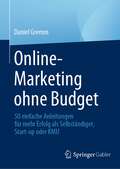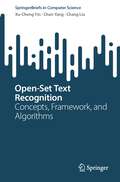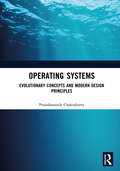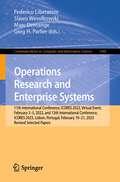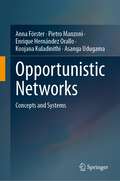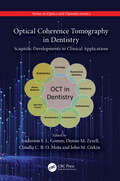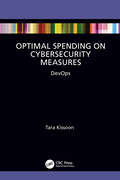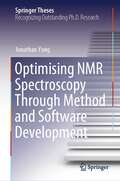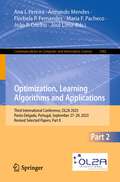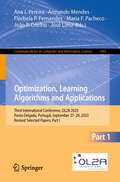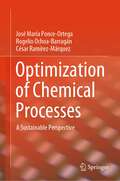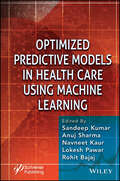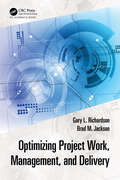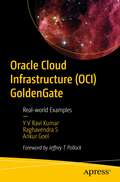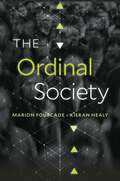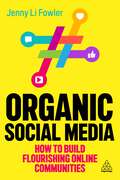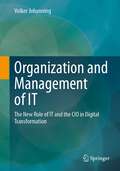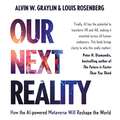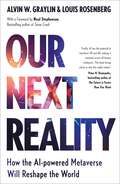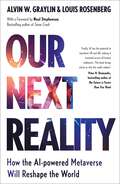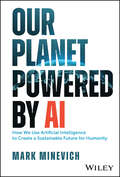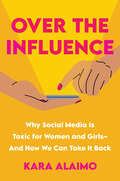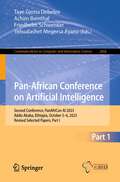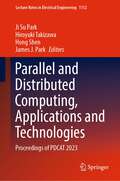- Table View
- List View
Online-Marketing ohne Budget: 50 einfache Anleitungen für mehr Erfolg als Selbständiger, Start-up oder KMU
by Daniel GremmDieses Buch ist dein Ratgeber und Leitfaden, mit dem du dein Online-Marketing mit leistbarem Aufwand systematisch zum Erfolg bringst, und zwar ganz ohne Budget!Du baust Dein eigenes Geschäft auf, brauchst dafür Online-Marketing, hast aber nicht viel Geld zur Verfügung? Du führst ein kleines Geschäft und willst jetzt endlich mit Online-Marketing starten, weißt aber noch nicht, wie das sinnvoll geht? Dann lies – und arbeite – mit diesem Buch!„Online-Marketing ohne Budget“ bietet dir 50 konkrete Anleitungen. Diese Anleitungen sind jeweils Marketingzielen zugeordnet, so dass du zielführend die für deine Situation bestmögliche Marketingidee in die Tat umsetzen kannst.Dieses Buch ist kein „Was-du-schon-immer-wissen-solltest-Buch“, sondern ein Arbeitsbuch. Wenn du es als Arbeitsbuch nutzt, dann wirst du dein Online-Marketing entscheidend voranbringen, versprochen!Jede Anleitung wird dir in drei einfachen Schritten beschrieben. Häufig erhältst du zudem auch einen Tipp für ein kostenloses Tool, das dich bei der Umsetzung unterstützt. Eine abschließende Checkliste nach jedem Kapitel hilft dir, den Überblick zu behalten und dich stetig in der Umsetzung zu halten. Aus dem Inhalt – jeweils 10 konkrete Marketing-Anleitungen zu den Zielen …Bekannter werden Traffic steigernMehr verkaufenKunden bindenMitarbeiter finden
Open-Set Text Recognition: Concepts, Framework, and Algorithms (SpringerBriefs in Computer Science)
by Xu-Cheng Yin Chun Yang Chang LiuIn real-world applications, new data, patterns, and categories that were not covered by the training data can frequently emerge, necessitating the capability to detect and adapt to novel characters incrementally. Researchers refer to these challenges as the Open-Set Text Recognition (OSTR) task, which has, in recent years, emerged as one of the prominent issues in the field of text recognition. This book begins by providing an introduction to the background of the OSTR task, covering essential aspects such as open-set identification and recognition, conventional OCR methods, and their applications. Subsequently, the concept and definition of the OSTR task are presented encompassing its objectives, use cases, performance metrics, datasets, and protocols. A general framework for OSTR is then detailed, composed of four key components: The Aligned Represented Space, the Label-to-Representation Mapping, the Sample-to-Representation Mapping, and the Open-set Predictor. In addition,possible implementations of each module within the framework are discussed. Following this, two specific open-set text recognition methods, OSOCR and OpenCCD, are introduced. The book concludes by delving into applications and future directions of Open-set text recognition tasks.This book presents a comprehensive overview of the open-set text recognition task, including concepts, framework, and algorithms. It is suitable for graduated students and young researchers who are majoring in pattern recognition and computer science, especially interdisciplinary research.
Operating Systems: Evolutionary Concepts and Modern Design Principles
by Pranabananda ChakrabortyThis text demystifies the subject of operating systems by using a simple step-by-step approach, from fundamentals to modern concepts of traditional uniprocessor operating systems, in addition to advanced operating systems on various multiple-processor platforms and also real-time operating systems (RTOSs). While giving insight into the generic operating systems of today, its primary objective is to integrate concepts, techniques, and case studies into cohesive chapters that provide a reasonable balance between theoretical design issues and practical implementation details. It addresses most of the issues that need to be resolved in the design and development of continuously evolving, rich, diversified modern operating systems and describes successful implementation approaches in the form of abstract models and algorithms. This book is primarily intended for use in undergraduate courses in any discipline and also for a substantial portion of postgraduate courses that include the subject of operating systems. It can also be used for self-study. Key Features • Exhaustive discussions on traditional uniprocessor-based generic operating systems with figures, tables, and also real-life implementations of Windows, UNIX, Linux, and to some extent Sun Solaris.• Separate chapter on security and protection: a grand challenge in the domain of today’s operating systems, describing many different issues, including implementation in modern operating systems like UNIX, Linux, and Windows.• Separate chapter on advanced operating systems detailing major design issues and salient features of multiple-processor-based operating systems, including distributed operating systems. Cluster architecture; a low-cost base substitute for true distributed systems is explained including its classification, merits, and drawbacks.• Separate chapter on real-time operating systems containing fundamental topics, useful concepts, and major issues, as well as a few different types of real-life implementations. • Online Support Material is provided to negotiate acute page constraint which is exclusively a part and parcel of the text delivered in this book containing the chapter-wise/topic-wise detail explanation with representative figures of many important areas for the completeness of the narratives.
Operations Research and Enterprise Systems: 11th International Conference, ICORES 2022, Virtual Event, February 3–5, 2022, and 12th International Conference, ICORES 2023, Lisbon, Portugal, February 19-21, 2023, Revised Selected Papers (Communications in Computer and Information Science #1985)
by Federico Liberatore Slawo Wesolkowski Marc Demange Greg H. ParlierThis book includes extended and revised versions of selected papers from the 11th and 12th editions of the International Conference on Operations Research and Enterprise Systems (ICORES 2022 and ICORES 2023). ICORES 2022 was held as a virtual event in February 2022, and ICORES 2023 was held in Lisbon, Portugal, in February 2023. The 5 full papers included in this book were carefully reviewed and selected from the 55 submissions for ICORES 2022, and 8 full papers were reviewed and selected from the 55 submissions for ICORES 2023. The papers are focused on operations research and enterprise systems.
Opportunistic Networks: Concepts and Systems
by Anna Förster Pietro Manzoni Enrique Hernández Orallo Koojana Kuladinithi Asanga UdugamaThis textbook provides an exhaustive exploration of Opportunistic Networks (OppNets). Divided into three parts, it starts with the foundational principles and metrics of OppNets, detailing their mobility and data dissemination. Significant focus is given to the security challenges faced by OppNets, including strategies to counter various attacks. The second part evaluates OppNets, introducing methods and metrics for assessment, theoretical and simulation models, and tools such as OMNeT++, The ONE and ns-3.This textbook also offers comparative analyses and discussions on benchmarking. The third part delves into the implementation of OppNets, discussing technologies from Mobile Ad Hoc Networks to satellite communication and their integration with cellular technologies like 4G, 5G and 6G. Detailed insight into device characterization reveals the potential and limitations of devices within OppNets. Practical applications of OppNets in scenarios such as disaster management, remotecommunication, IoT challenges, smart cities and satellite networks are presented as well. Through detailed discussions and case studies, readers gain a comprehensive understanding of the structure, operation and practical implications of OppNets. It equips readers with knowledge to appreciate the vast potential of OppNets in various applications and settings.This textbook targets advanced-level students and postdocs in computer science and electrical engineering as well as researchers, who are starting new in the area and need a comprehensive view of opportunistic networks. Practitioners who are interested in applying the concepts of opportunistic networks in their products and services, and would like to have a jump start into the development and applications of opportunistic networks will also want to purchase this book as a reference.
Optical Coherence Tomography in Dentistry: Scientific Developments to Clinical Applications (Series in Optics and Optoelectronics)
by Gomes, Anderson S. L.Optical Coherence Tomography (OCT), a method to "see inside of things" without destroying them, has been applied to subjects ranging from materials science to medicine. This book focuses on the biomedical application of OCT in dentistry, covering topics from dental materials to clinical practice. Since the introduction of the OCT method in ophthalmology in 1991, and then dentistry in 1998, developments in OCT methods, particularly in biomedical areas, have led to its dissemination worldwide. The chapters of this book cover the basics and recent global advances of OCT in dentistry, including an overview of the method and its use in cariology, restorative dentistry, dental materials, endodontics, pediatric dentistry, orthodontics, prosthodontics, soft oral tissues and nanodentistry. This book will be of interest to both newcomers in the field as well as those already working in OCT, either in research and/or the clinic. It will be of great use in courses on optical imaging applied to biomedical areas, particularly where it can provide real-life examples of the application of OCT.
Optimal Spending on Cybersecurity Measures: DevOps
by Tara KissoonOptimal Spending on Cybersecurity Measures: DevOps aims to discuss the integration of risk management methodologies within the DevOps process.This book introduces the cyber risk investment model, and the cybersecurity risk management framework within the DevOps process. This can be used by various stakeholders who are involved in the implementation of cybersecurity measures to safeguard sensitive data. This framework facilitates an organization’s risk management decision-making process to demonstrate the mechanisms in place to fund cybersecurity measures within DevOps practices, and demonstrates the application of the process using a case study: Cascade. This book also discusses the elements used within DevOps, DevSecOps, and will define a strategic approach to minimize cybersecurity risks within DevOps known as DevRiskOps.Features: Aims to strengthen the reader’s understanding of industry governance, risk and compliance practices. Incorporates an innovative approach to assess cyber security initiatives with DevOps. Explores the strategic decisions made by organizations when implementing cybersecurity measures and leverages an integrated approach to include risk management elements into DevOps.
Optimising NMR Spectroscopy Through Method and Software Development (Springer Theses)
by Jonathan YongThis book provides a comprehensive overview of Nuclear Magnetic Resonance (NMR) theory, its applications, and advanced techniques to improve the quality and speed of NMR data acquisition. In this book, the author expands his outstanding Ph.D. thesis and provides a valuable resource for researchers, professionals, and students in the field of NMR spectroscopy. The book covers quantum mechanics basics, and topics like density operators, pulse sequences, 1D pulse acquisition, INEPT (Insensitive nuclei enhancement by polarization transfer), product operators, and 2D NMR principles. It also explores innovative experiments like States HSQC (Heteronuclear Single Quantum Coherence) and echo-antiecho HSQC with gradients. In the subsequent chapters, the author discusses Pure Shift NMR, including PSYCHE (Pure Shift Yielded by Chirp Excitation) and its optimizations, such as waveform parameterization and time-reversal methods. The 'Discrete PSYCHE' approach and Ultrafast PSYCHE-iDOSY (Diffusion-ordered spectroscopy) are also highlighted. This book presents the POISE (Parameter Optimisation by Iterative Spectral Evaluation) software for real-time NMR experiment optimization, including pulse width calibration and Ernst angle optimization, and demonstrates applications across various NMR experiments. Lastly, the book examines accelerated 2D NMR data collection and the NOAH (NMR by Ordered Acquisition using 1H detection) supersequences, emphasizing automated pulse program creation using GENESIS (GENEration of Supersequences In Silico). Covered NMR experiments include 13C sensitivity-enhanced HSQC, 15N HMQC (Heteronuclear Multiple Quantum Coherence), dual HSQC, HSQC-TOCSY (Total Correlation Spectroscopy), HMBC (Heteronuclear Multiple Bond Correlation), and ADEQUATE (Adequate Sensitivity Double-Quantum Spectroscopy).
Optimization, Learning Algorithms and Applications: Third International Conference, OL2A 2023, Ponta Delgada, Portugal, September 27–29, 2023, Revised Selected Papers, Part II (Communications in Computer and Information Science #1982)
by Ana I. Pereira Armando Mendes Florbela P. Fernandes Maria F. Pacheco João P. Coelho José LimaThis two-volume set CCIS 1981 and 1982 constitutes the refereed post-conference proceedings of the Third International Conference on Optimization, Learning Algorithms and Applications, OL2A 2023, held in Ponta Delgada, Portugal, in September 2023.The 66 revised full papers presented in these proceedings were carefully reviewed and selected from 162 submissions. The papers are organized in the following topical sections:Volume I:Machine learning; learning algorithms in engineering education; machine learning and data analysis in internet of things; optimization; optimization in the SDG context.Volume II:Computer vision based on learning algorithms; machine learning and AI in robotics; optimization in control systems design.
Optimization, Learning Algorithms and Applications: Third International Conference, OL2A 2023, Ponta Delgada, Portugal, September 27–29, 2023, Revised Selected Papers, Part I (Communications in Computer and Information Science #1981)
by Ana I. Pereira Armando Mendes Florbela P. Fernandes Maria F. Pacheco João P. Coelho José LimaThis two-volume set CCIS 1981 and 1982 constitutes the refereed post-conference proceedings of the Third International Conference on Optimization, Learning Algorithms and Applications, OL2A 2023, held in Ponta Delgada, Portugal, in September 2023.The 66 revised full papers presented in these proceedings were carefully reviewed and selected from 162 submissions. The papers are organized in the following topical sections:Volume I:Machine learning; learning algorithms in engineering education; machine learning and data analysis in internet of things; optimization; optimization in the SDG context.Volume II:Computer vision based on learning algorithms; machine learning and AI in robotics; optimization in control systems design.
Optimization of Chemical Processes: A Sustainable Perspective
by José María Ponce-Ortega Rogelio Ochoa-Barragán César Ramírez-MárquezThis textbook introduces readers to a comprehensive framework for the application of deterministic optimization strategies in the field of chemical processes, with a strong emphasis on sustainability.The book establishes a vital connection between fundamental deterministic optimization principles, optimization tools, and real-world application instances, all within the context of environmentally responsible practices. The approach put forth in this book is exceptionally versatile, allowing for the use of many optimization software and deterministic techniques.Contained in the book are many fundamental optimization concepts, encompassing linear programming, nonlinear programming, integer programming, and multi-objective optimization, all tailored to promote sustainable decision-making. Furthermore, the book provides practical examples illustrating the application of these techniques within sustainable chemical processes as tutorials.The textbook also explores the utilization of popular optimization software platforms such as GAMS, MATLAB, and Python, demonstrating how these tools can be leveraged for eco-friendly process optimization. Through this comprehensive framework, readers can not only acquire the skills needed to optimize a wide range of processes but also learn how to do so with sustainability at the forefront of their considerations. This approach streamlines the optimization process, eliminating unnecessary complications along the way and ensuring that environmental and ethical considerations are integral to the decision-making process.
Optimized Predictive Models in Health Care Using Machine Learning
by Sandeep Kumar Anuj Sharma Navneet Kaur Lokesh Pawar Rohit BajajOPTIMIZED PREDICTIVE MODELS IN HEALTH CARE USING MACHINE LEARNING This book is a comprehensive guide to developing and implementing optimized predictive models in healthcare using machine learning and is a required resource for researchers, healthcare professionals, and students who wish to know more about real-time applications. The book focuses on how humans and computers interact to ever-increasing levels of complexity and simplicity and provides content on the theory of optimized predictive model design, evaluation, and user diversity. Predictive modeling, a field of machine learning, has emerged as a powerful tool in healthcare for identifying high-risk patients, predicting disease progression, and optimizing treatment plans. By leveraging data from various sources, predictive models can help healthcare providers make informed decisions, resulting in better patient outcomes and reduced costs. Other essential features of the book include: provides detailed guidance on data collection and preprocessing, emphasizing the importance of collecting accurate and reliable data; explains how to transform raw data into meaningful features that can be used to improve the accuracy of predictive models; gives a detailed overview of machine learning algorithms for predictive modeling in healthcare, discussing the pros and cons of different algorithms and how to choose the best one for a specific application; emphasizes validating and evaluating predictive models; provides a comprehensive overview of validation and evaluation techniques and how to evaluate the performance of predictive models using a range of metrics; discusses the challenges and limitations of predictive modeling in healthcare; highlights the ethical and legal considerations that must be considered when developing predictive models and the potential biases that can arise in those models. Audience The book will be read by a wide range of professionals who are involved in healthcare, data science, and machine learning.
Optimizing Project Work, Management, and Delivery
by Gary L. Richardson Brad M. JacksonThousands of project management–related books have been written. Why is Optimizing Project Work, Management, and Delivery different? This book represents the authors’ experiences gained from looking at the problem of project management for 50 years and wondering why projects cannot be more successful. Experience from various management models and techniques has helped but still does not fit reality or provide accurate forecasts. Industry surveys have compiled the root causes of project failure, and yet they persist. Is there no answer to this problem? As the book explains, the management solution is not in the models or the theory but is found in how they are mapped against the actual target project characteristics. This is the book’s unique strength. There are major coverage gaps in current project management models that also need to be recognized. All of the existing models are correct in some ways, and yet each is also wrong. The book starts by reviewing popular models and related topics that help construct the building blocks of an integrated model structure, which is at the core of this book. The integrated model described here is meant to be a decision-oriented view related to the project life cycle rather than a cookbook of success steps. Project management is too complex for a cookbook approach. This text helps managers find that right path.
Oracle Cloud Infrastructure (OCI) GoldenGate: Real-world Examples
by Y V Ravi Kumar Raghavendra S Ankur GoelThis book focuses on the utilization of GoldenGate Services (GGS) in conjunction with a microservices architecture on the Oracle cloud (OCI), primarily for data migration and integration across various data sources and targets.The book begins with a practical example of utilizing GGS on a Marketplace VM, progressively advancing to in-depth discussions on implementing GoldenGate as a Service on OCI. The book offers illustrative guides for data replication between RDBMSs (such as Oracle, Postgres, and big data targets such as Kafka). Additionally, it explores monitoring techniques using Enterprise Manager and Grafana dashboards. A comparative analysis is presented between traditional VM-based GoldenGate installations and the OCI service model. Special attention is given to Zero Downtime Migration (ZDM) and leveraging GGS for database migration from on-premises to OCI. Some chapters address multi-cloud replication using OCI GGS and include real-life case studies.By the end of this book you will have gained comprehensive insights into the architectural design of GoldenGate Services and will be adept at replicating data using GGS, enabling you to replicate setups in your own environments.What You Will LearnSet up GoldenGate Services for high availability (HA), disaster recovery (DR), migration of data to cloud, and moving data into the data lake or lakehousePerform logical migration of data to the cloud using the ZDM tool (ZDM uses GoldenGate internally).Replicate data to big data targetsMonitor GGS using Enterprise Manager and GrafanaReplicate data in a multi-cloud environment Who This Book Is ForOracle database administrators who want to replicate data or use Oracle GoldenGate Services for migration and setup of high availability (HA) and disaster recovery (DR); and data engineers who want tobuild the data warehouse, data lake, data lakehouse to push data in near real-time
The Ordinal Society
by Marion Fourcade Kieran HealyA sweeping critique of how digital capitalism is reformatting our world.We now live in an “ordinal society.” Nearly every aspect of our lives is measured, ranked, and processed into discrete, standardized units of digital information. Marion Fourcade and Kieran Healy argue that technologies of information management, fueled by the abundance of personal data and the infrastructure of the internet, transform how we relate to ourselves and to each other through the market, the public sphere, and the state.The personal data we give in exchange for convenient tools like Gmail and Instagram provides the raw material for predictions about everything from our purchasing power to our character. The Ordinal Society shows how these algorithmic predictions influence people’s life chances and generate new forms of capital and social expectation: nobody wants to ride with an unrated cab driver anymore or rent to a tenant without a risk score. As members of this society embrace ranking and measurement in their daily lives, new forms of social competition and moral judgment arise. Familiar structures of social advantage are recycled into measures of merit that produce insidious kinds of social inequality.While we obsess over order and difference—and the logic of ordinality digs deeper into our behaviors, bodies, and minds—what will hold us together? Fourcade and Healy warn that, even though algorithms and systems of rationalized calculation have inspired backlash, they are also appealing in ways that make them hard to relinquish.
Organic Social Media: How to Build Flourishing Online Communities
by Jenny Li FowlerOrganizations and institutions focused on community building have a built-in group of ambassadors who embrace their message and vision. Social media managers have a unique opportunity to lean into this loyalty by creating a social presence informed by this digital engagement. In Organic Social Media, Jenny Li Fowler outlines the important steps that social media managers need to take to enhance an organization's broader growth objectives. Fowler breaks down the important questions to help readers determine the best platforms to invest in, how they can streamline the approval process and other essential strategic steps to create an organic following on social platforms.Organic Social Media explains how to elevate the key growth objectives of a brand by creating or recreating its online presence. Early chapters walk readers through the planning phase, the process of strategic goal setting, platform selection, resource management and content discovery. Later chapters focus on executing these established plans and offer a strategic way to build a content calendar and track the success of social. With this book, social media managers will future-proof the online presence of any organization.
Organization and Management of IT: The New Role of IT and the CIO in Digital Transformation
by Volker JohanningThis book takes a practical look at how IT organizations need to position themselves optimally in this dynamically changing world and what this means for the leadership of this increasingly important IT. In addition, the book takes a closer look at the topic of managing an IT organization: What is the role and what are the leadership responsibilities of a CIO? How and by what means can an IT organization best be managed? How can complex change processes and transformations be managed? Thus, the book offers a practical guide for organizational change or reorganization of IT with many tips on change management, leadership, and agile methods and approaches in the new IT organization.
Our Next Reality: How the AI-powered Metaverse Will Reshape the World
by Alvin Wang Graylin Louis Rosenberg"Our Next Reality does a fantastic job of giving a balanced and insightful analysis to some of the most pressing questions our society will face in the near future. The material is data driven, digestible, and very actionable." RAY KURZWEIL, Author/Entrepreneur/Futurist"A wide-reaching exploration of the intersections between AI, VR and AR: it's a mind-opener, and a source of reflection on how transformative and still unknown the future of communication, personal technology and even personal privacy might become." SCOTT STEIN, Editor at Large, CNETOver the last 100 years, technology has changed our world. Over the next decade it will transform our reality.We are entering a new technological age in which artificial intelligence and immersive media will transform society at all levels, mediating our lives by altering what we see, hear, and experience. Powered by immersive eyewear and driven by interactive AI agents, this new age of computing has the potential to make our world a magical place where the boundaries between the real and the virtual, the human and the artificial, rapidly fade away. If managed well, this could unleash a new age of abundance. If managed poorly, this technological revolution could easily go astray, deeply compromising our privacy, autonomy, agency, and even our humanity.In Our Next Reality, two industry veterans provide a data-driven debate on whether the new world we're creating will be a technological utopia or an AI-powered dystopia and give guidance on how to aim for the best future we can. With a Foreword by renowned author Neal Stephenson and section contributions from industry thought-leaders such as Peter H. Diamandis, Tom Furness, Phillip Rosedale, Tony Parisi, Avi Bar Zeev and Walter Parkes, this book answers over a dozen of the most pressing questions we face as artificial intelligence and spatial computing accelerates the digitization of our world. Find out why our actions in the next decade could determine the trajectory of our species for countless millennia."For anyone who wants to use AI and XR to help build the future, read this book to help you skillfully navigate a future of unprecedented danger and promise." JASON HINER, Editor in Chief, ZDNet"Our Next Reality really is a must-read for anyone who wants to prepare for the massive AI and XR driven disruption coming our way." CHARLIE FINK, Author | Adjunct | Forbes Tech Columnist
Our Next Reality: How the AI-powered Metaverse Will Reshape the World
by Alvin Wang Graylin Louis RosenbergForeword by Neal Stephenson, bestselling author of Snow Crash Over the last 100 years, technology has changed our world. Over the next decade it will transform our reality. The planet is headed for a momentous upheaval, and we are not prepared. We are entering a new technological age in which artificial intelligence and immersive media will transform society at all levels, mediating our lives by altering what we see, hear, and experience. Powered by immersive eyewear and driven by interactive AI agents, this new age of computing has the potential to make our world a magical place where the boundaries between the real and the virtual, the human and the artificial, rapidly fade away. If managed well, this could unleash a new age of abundance. If managed poorly, this technological revolution could easily go astray, deeply compromising our privacy, autonomy, agency, and even our humanity. In Our Next Reality, two industry veterans provide a data-driven debate on whether the new world we're creating will be a technological utopia or an AI-powered dystopia and give guidance on how to aim for the best future we can. With a Foreword by renowned author Neal Stephenson and section contributions from industry thought-leaders such as Peter H. Diamandis, Tom Furness, Phillip Rosedale, Tony Parisi, Avi Bar Zeev and Walter Parkes, this book answers over a dozen of the most pressing questions we face as AI/VR/AR accelerates the digitization of our world. Find out why our actions in the next decade could determine the trajectory of our species for countless millennia.
Our Next Reality: How the AI-powered Metaverse Will Reshape the World
by Alvin Wang Graylin Louis Rosenberg"Our Next Reality does a fantastic job of giving a balanced and insightful analysis to some of the most pressing questions our society will face in the near future. The material is data driven, digestible, and very actionable." RAY KURZWEIL, Author/Entrepreneur/Futurist"A wide-reaching exploration of the intersections between AI, VR and AR: it's a mind-opener, and a source of reflection on how transformative and still unknown the future of communication, personal technology and even personal privacy might become." SCOTT STEIN, Editor at Large, CNETOver the last 100 years, technology has changed our world. Over the next decade it will transform our reality.We are entering a new technological age in which artificial intelligence and immersive media will transform society at all levels, mediating our lives by altering what we see, hear, and experience. Powered by immersive eyewear and driven by interactive AI agents, this new age of computing has the potential to make our world a magical place where the boundaries between the real and the virtual, the human and the artificial, rapidly fade away. If managed well, this could unleash a new age of abundance. If managed poorly, this technological revolution could easily go astray, deeply compromising our privacy, autonomy, agency, and even our humanity.In Our Next Reality, two industry veterans provide a data-driven debate on whether the new world we're creating will be a technological utopia or an AI-powered dystopia and give guidance on how to aim for the best future we can. With a Foreword by renowned author Neal Stephenson and section contributions from industry thought-leaders such as Peter H. Diamandis, Tom Furness, Phillip Rosedale, Tony Parisi, Avi Bar Zeev and Walter Parkes, this book answers over a dozen of the most pressing questions we face as artificial intelligence and spatial computing accelerates the digitization of our world. Find out why our actions in the next decade could determine the trajectory of our species for countless millennia."For anyone who wants to use AI and XR to help build the future, read this book to help you skillfully navigate a future of unprecedented danger and promise." JASON HINER, Editor in Chief, ZDNet"Our Next Reality really is a must-read for anyone who wants to prepare for the massive AI and XR driven disruption coming our way." CHARLIE FINK, Author | Adjunct | Forbes Tech Columnist
Our Next Reality: How the AI-powered Metaverse Will Reshape the World
by Alvin Wang Graylin Louis Rosenberg"Our Next Reality does a fantastic job of giving a balanced and insightful analysis to some of the most pressing questions our society will face in the near future. The material is data driven, digestible, and very actionable." RAY KURZWEIL, Author/Entrepreneur/Futurist"A wide-reaching exploration of the intersections between AI, VR and AR: it's a mind-opener, and a source of reflection on how transformative and still unknown the future of communication, personal technology and even personal privacy might become." SCOTT STEIN, Editor at Large, CNET"For anyone who wants to use AI and XR to help build the future, read this book to help you skillfully navigate a future of unprecedented danger and promise." JASON HINER, Editor in Chief, ZDNet"Our Next Reality really is a must-read for anyone who wants to prepare for the massive AI and XR driven disruption coming our way." CHARLIE FINK, Author | Adjunct | Forbes Tech ColumnistOver the last 100 years, technology has changed our world. Over the next decade it will transform our reality.We are entering a new technological age in which artificial intelligence and immersive media will transform society at all levels, mediating our lives by altering what we see, hear, and experience. Powered by immersive eyewear and driven by interactive AI agents, this new age of computing has the potential to make our world a magical place where the boundaries between the real and the virtual, the human and the artificial, rapidly fade away. If managed well, this could unleash a new age of abundance. If managed poorly, this technological revolution could easily go astray, deeply compromising our privacy, autonomy, agency, and even our humanity.In Our Next Reality, two industry veterans provide a data-driven debate on whether the new world we're creating will be a technological utopia or an AI-powered dystopia and give guidance on how to aim for the best future we can. With a Foreword by renowned author Neal Stephenson and section contributions from industry thought-leaders such as Peter H. Diamandis, Tom Furness, Phillip Rosedale, Tony Parisi, Avi Bar Zeev and Walter Parkes, this book answers over a dozen of the most pressing questions we face as artificial intelligence and spatial computing accelerates the digitization of our world. Find out why our actions in the next decade could determine the trajectory of our species for countless millennia.
Our Planet Powered by AI: How We Use Artificial Intelligence to Create a Sustainable Future for Humanity
by Mark MinevichA hands-on guide to evolving your company with ethical AI along with thought-provoking insights and predictions from a variety of well-known industry leaders In Our Planet Powered by AI, renowned AI strategist and pioneer Mark Minevich delivers an exciting and practical discussion of how to implement groundbreaking artificial intelligence technologies at every level of your organization. You’ll learn to create sustainable, effective competitive advantage by introducing previously unheard-of levels of adaptability, resilience, and innovation into your company. Using real-world case studies from a variety of well-known industry leaders, the author explains the strategic archetypes, technological infrastructures, and cultures of sustainability you’ll need to ensure your firm’s next-level digital transformation takes root. You’ll also discover: How AI can enable new business strategies, models, and ecosystems of innovation and growth How to develop societal impact and powerful organizational benefits with ethical AI implementations that incorporate transparency, fairness, privacy, and reliability What it means to enable all-inclusive artificial intelligence An engaging and hands-on exploration of how to take your firm to new levels of dynamism and growth, Our Planet Powered by AI will earn a place in the libraries of managers, executives, directors, and other business and technology leaders seeking to distinguish their companies in a new age of astonishing technological advancement and fierce competition.
Over the Influence: Why Social Media is Toxic for Women and Girls - And How We Can Take it Back
by Kara AlaimoThis essential book is a rallying cry for women to recognize and reject the ways social media is being weaponized against us — and instead wield it to empower ourselves.In Over the Influence, communication professor and CNN Opinion contributor Kara Alaimo reveals how social media is affecting every aspect of the lives of women and girls—from our relationships and our parenting to our physical and mental well-being. Over the Influence is a book about what it means to live in the world social media has wrought—whether you&’re constantly connected or have deleted your accounts forever. Alaimo shows why you&’re likely to get fewer followers if you&’re a woman. She explains how fake news is crafted to prey on women&’s vulnerabilities. She reveals why so much of the content we find in our feeds is specifically designed to hold us back. And she explains how social media has made the offline world an uglier place for women.But we can change this. Alaimo offers up brilliant advice for how to get over the influence—how to handle our daughters&’ use of social media, use dating apps to find the partners we&’re looking for, use social networks to bolster our careers, and protect ourselves from sextortionists, catfishers, and trolls. She also explains what we need to demand from lawmakers and tech companies.Over the Influence calls on women to recognize and call out the subtle (and not-so-subtle) sexism and misogyny we find online, reject misinformation that is targeted to us because of our gender, and use our platforms to empower ourselves and other women.
Pan-African Conference on Artificial Intelligence: Second Conference, PanAfriCon AI 2023, Addis Ababa, Ethiopia, October 5–6, 2023, Revised Selected Papers, Part I (Communications in Computer and Information Science #2068)
by Taye Girma Debelee Achim Ibenthal Friedhelm Schwenker Yehualashet Megersa AyanoThis two-volume set, CCIS 2068 and 2069, constitutes selected papers presented during the Second Pan-African Conference on Artificial Intelligence, PanAfriCon AI 2023, held in Addis Ababa, Ethiopia, in October 2023. The set goal of the conference is to exchange the best practices of joint Pan-African efforts to provide solutions for Africa’s key 21st century challenges in the social, economic and ecologic domains. The 29 papers were thoroughly reviewed and selected from 134 submissions. The papers are organized in the following topical sections: Medical AI; Natural Language Processing, Text and Speech Processing; AI in Finance and Cyber Security; Autonomous Vehicles; AI Ethics and Life Sciences.
Parallel and Distributed Computing, Applications and Technologies: Proceedings of PDCAT 2023 (Lecture Notes in Electrical Engineering #1112)
by Ji Su Park Hiroyuki Takizawa Hong Shen James J. ParkThis book constitutes the refereed proceedings of the International Conference on Parallel and Distributed Computing, Applications and Technologies (PDCAT) which was held in Jeju, Korea in August, 2023. The papers of this volume are organized in topical sections on wired and wireless communication systems, high dimensional data representation and processing, networks and information security, computing techniques for efficient networks design, electronic circuits for communication systems.
